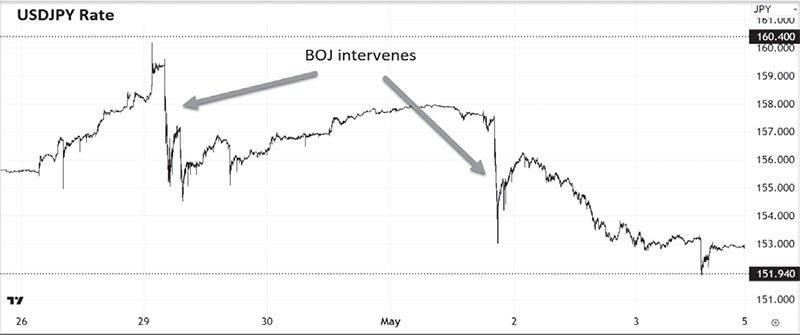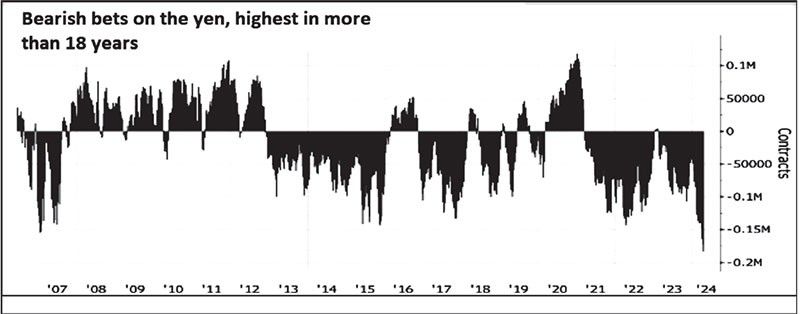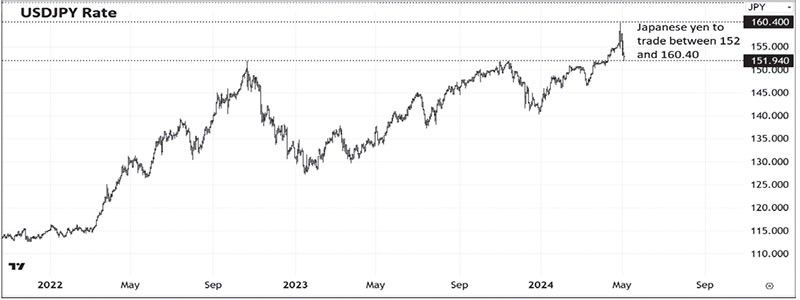BOJ actions fuel yen’s biggest rally

The Japanese yen surged 3.39 percent against the US dollar last week. This marked its biggest weekly gain since December 2022. The rally was fueled by suspected intervention from the Bank of Japan (BOJ) which helped steer the currency away from a 34-year low. After breaching the 160-level last week, the Japanese currency closed strongly at 152.928 last Friday.
BOJ steps in as yen plummets
Data from the BOJ suggests that Japan intervened twice in the foreign exchange market last week. This is to support the yen as it plummeted to 160.21 per dollar on Monday, a level not seen since 1990. A Bloomberg analysis comparing BOJ accounts with money broker forecasts estimated that the central bank spent around 9 trillion yen (or $58.9 billion) to prop up the currency.

Source: Tradingview, Wealth Securities Research
Yield differential weighs on yen
The BOJ has not officially confirmed the interventions. However, Japanese Finance Minister Shunichi Suzuki told reporters at the Asian Development Bank’s annual meeting on Friday, “When there is excessive movement, it may be necessary to smooth it out.” The yen has been under pressure as the BOJ maintains an ultra-loose monetary policy while other major central banks like the US Federal Reserve (Fed) are looking at maintaining interest rates “higher for longer.” This has led to a widening yield gap that makes the yen less attractive against the dollar.
Bearish bets on yen reach 18-year high
The BOJ’s apparent intervention came as bearish bets against the yen hit the highest levels in at least 18 years, according to data from the US Commodity Futures Trading Commission (CFTC). This extreme positioning could potentially serve as a contrarian indicator, suggesting a short-term bottom for the yen.

Source: CFTC, Bloomberg
Weak US jobs data boosts yen
Friday’s US jobs report also aided the yen’s rally. The Japanese currency strengthened to an intraday high of 151.86 against the US dollar after April’s non-farm payrolls showed 175,000 jobs gained which is below the 240,000 expected. The market is now pricing in a rate cut in September and a second cut by the end of the year. Rates dropped following the weak jobs report with the US 10-year yield falling below 4.5 percent.
A turning point or temporary relief?
The BOJ’s suspected interventions have led to a sharp appreciation in the yen, with the currency strengthening from a weekly low of 160.21 against the dollar to close near 152. Looking ahead, technical analysis suggests a likely consolidation of the yen between 152 and 160.40.
The yen’s sharp recovery over the past week may provide a boost to regional currencies, including the Philippine peso, just as it had previously amplified the effects of “higher-for-longer” US rates. Investors should closely watch the yen’s movement in the coming weeks to determine whether this marks the beginning of a broader reversal or merely a temporary respite in the currency’s long-term decline.

Source: Tradingview, Wealth Securities Research
Philequity Management is the fund manager of the leading mutual funds in the Philippines. Visit www.philequity.net to learn more about Philequity’s managed funds or to view previous articles. For inquiries or to send feedback, please call (02) 8250-8700 or email ask@philequity.net.
- Latest
- Trending






















